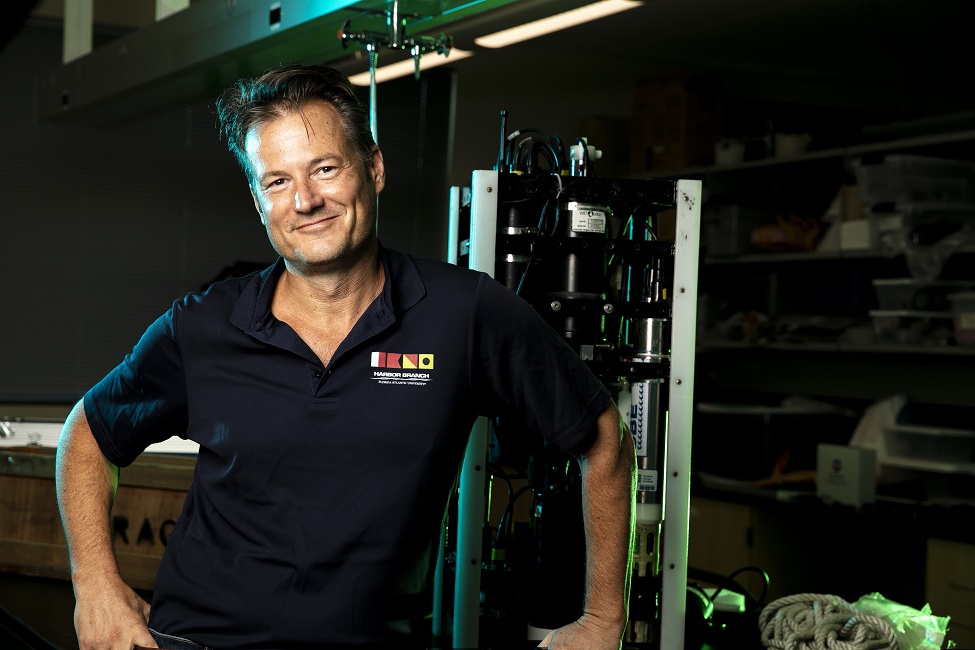FAU Lands $11 Million Contract from U.S. Office of Naval Research

Michael Twardowski, Ph.D., principal investigator and a research professor at FAU’s Harbor Branch, is working with the U.S. Office of Naval Research and academic and corporate partners to develop a next generation ‘gold standard’ sensor that will be compact and versatile in deployment and continue a legacy of research in oceanic bioluminescence and its role in ocean ecology. (Photo by Alex Dolce)
From the ocean surface to the deep seafloor, bioluminescent creatures are found throughout marine habitats. This “glowing” energy released from chemical reactions emitted by these organisms is used to warn or evade predators, lure or detect prey and communicate with members of the same species. Research surrounding bioluminescence will soon serve as an important tool to protect the coastlines of the United States.
Florida Atlantic University’s Harbor Branch Oceanographic Institute has landed an $11,179,001 four-year contract from the United States Office of Naval Research (ONR) to develop a next-generation, high-intake, compact, defined excitation bathyphotometer sensor for natural oceanic bioluminescence assessments. The contract will also involve imaging, modeling, and significant field work to better understand bioluminescence dynamics in the ocean. Bathyphotometer measurements of bioluminescence are used to study light emissions from populations of luminescent marine organisms including phytoplankton and zooplankton. Water motion from the movements of fish, dolphins, and whales can stimulate such light emissions and the bathyphotometer measures the total capacity for these emissions.
“It is great news that the U.S. Office of Naval Research has contracted with Florida Atlantic University to develop advanced bioluminescence technology,” said U.S. Sen. Marco Rubio. “This research is critical to protecting not only Florida’s coastlines, but all of our nation’s coastlines. I look forward to seeing the work that the Harbor Branch Oceanographic Institute will produce as a result of this contract.”
The project, “Next Generation Sensor Systems for Natural Oceanic Bioluminescence Assessments,” was competitively procured under the “Long Range Broad Agency Announcement (BAA) for Navy and Marine Corps Science and Technology,” under the purview of the ONR.
Nearly all coastal and open ocean regions, particularly waters with high productivity, have conditions favorable for bioluminescence emission at night. Bioluminescence can be detected remotely, above water, with the naked eye or with camera systems. No current bioluminescence measurement system has the ability to measure the full light emission potential of the organisms in the water column. Existing bathyphotometers with low flow rates are typically relevant only for passive phytoplankton, usually found near the water’s surface.
“Technology to determine how bioluminescent organisms are distributed in space and time and how they may affect the light environment at night is lacking. We also need the measurements and models to understand how larger marine animals like whales and dolphins stimulate bioluminescence through their swimming motions,” said Michael Twardowski, Ph.D., principal investigator and a research professor at FAU’s Harbor Branch. “Working with the U.S. Office of Naval Research and our academic and corporate partners, we are not only developing a next generation ‘gold standard’ sensor that will be compact and versatile in deployment, but continuing a legacy of research in oceanic bioluminescence and its role in ocean ecology.”
The first core goal of this project is to improve assessments from bioluminescence for the comprehensive organism field utilizing the next generation bathyphotometer being developed by FAU’s Harbor Branch, which will involve field testing in a wide range of sites. The second goal of the project will be to develop an integrated imaging system payload for autonomous platforms such as high and low altitude drones and surface vehicles. The imaging systems developed by FAU’s Harbor Branch will use a novel approach during collection with specific algorithms that are far more efficient at preserving information.
“We are extremely grateful for Sen. Rubio’s continued support and for his leadership in assisting us to acquire this significant contract from the United States Office of Naval Research,” said Daniel C. Flynn, Ph.D., FAU’s vice president for research. “Not only will our project help to secure our coastline from potential threats it also will help to stimulate economic development and growth in this region and create new, high-tech jobs.”
Project collaborators are the University of South Florida, St. Petersburg; University of Florida, Fort Pierce; Scripps Institute of Oceanography, University of California-San Diego; Texas Christian University; Florida International University; and Tonizzo Consulting.
“For more than 50 years, Florida Atlantic University’s Harbor Branch Oceanographic Institute has been at the forefront of marine science and technology. This monumental award is a testament to our talented researchers who dedicate their lives to improving and protecting our quality of life,” said James Sullivan, Ph.D., co-investigator and executive director of FAU’s Harbor Branch. “We look forward to working with the Office of Naval Research and our academic and commercial partners on this vital project, which will further enhance and ‘illuminate’ our understanding of ocean ecology.”
Co-principal investigators are Bing Ouyang, Ph.D., associate research professor, FAU’s Harbor Branch; Timothy Moore, Ph.D., research professor, FAU’s Harbor Branch; Aditya Nayak, Ph.D., assistant professor, FAU’s College of Engineering and Computer Science; Malcolm McFarland, Ph.D., research associate, FAU’s Harbor Branch; Fraser Dalgleish, Ph.D., affiliate research professor, FAU’s Harbor Branch; Laurent Cherubin, Ph.D., associate research professor, FAU’s Harbor Branch; Jason Hallstrom, Ph.D., professor, FAU’s College of Engineering and Computer Science and director of FAU’s Institute for Sensing and Embedded Network Systems Engineering (I-SENSE); and Siddartha Verma, Ph.D., assistant professor, FAU’s College of Engineering and Computer Science.
-FAU-
Tags: science | faculty and staff | engineering | research | harbor branch | technology